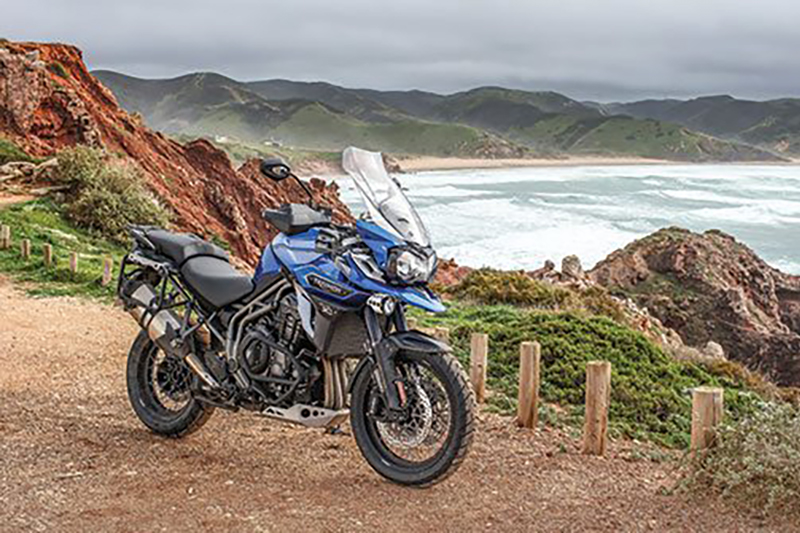2016 Triumph Tiger Explorer XCa

First Ride Review
Today’s adventure-touring segment already offers a dizzying selection, to which Triumph now adds a whole family of next-generation 2016 Tiger Explorers. Three focus on street riding (XR, XRx and XRt), and two XC versions gear up for off-road adventure (XCx and XCa). The mid-level XRx and XCx models can be equipped with shortened suspension and an adjustable low seat (30.9 inches vs. the standard 33.0). These variations let buyers select the best package for individual needs, but even the base XR comes chock-full of enhancements.
New features common to all include a smaller, less-restrictive exhaust system and all-new engine mapping for the 1,215cc three-cylinder DOHC mill, for more horsepower and torque along with improved fuel economy; torque-assist clutch for a 30-percent reduction in lever effort; premium, adjustable WP suspension front and rear; radial-mount monobloc Brembo 4-piston front brakes; multiple-mode throttle mapping, ABS and traction control; multiple, programmable riding modes; electrically adjustable windscreen; multi-function LCD instrument pack; sump guard and centerstand; 12-volt and USB sockets; new styling and improved aerodynamics.
All XRs feature new 10-spoke cast aluminum-alloy wheels, while the off-road XCs use 32-spoke tubeless, aluminum rims. Rim sizes jump from 2.75 inches in front to 3.00, with rear wheels growing from 4.25 inches to 4.5. New Tourance Next E tires (120/70-R19 front, 170/60-R17 rear) were developed by Metzeler in conjunction with Triumph specifically for Explorer fitment.
Mid- and top-level Explorers incorporate more but first, here’s what we learned aboard a fully equipped off-road XCa during a one-day ride through the hills of Portugal. The route spanned 170 miles, including fast sweepers, easy cruising, tight twisty roads, bumpy, broken, patched pavement and dirt roads with some steep, rocky, semi-challenging sections. This itinerary alone spoke volumes about the new bike: Triumph didn’t cherry-pick roads that would only show the Explorer at it’s best. Rather, we flogged the bike over a full range of riding conditions, including some very nasty spots, over the course of a long day. Bottom line: the Explorer’s not only an excellent all-around street mount, it’s also startlingly good in the dirt.
Steering is amazingly light in effort, linear in action and delightfully responsive. Picking the bike up mid-corner to change lines happens with the speed of thought, yet the front end always feels planted and reassuring. The bike feels light and short, belying its chassis specs, not as long or tall or heavy as its numbers might imply. Credit the chassis updates; the frame’s basically unchanged, but the WP fork is 10mm shorter than before to quicken up the steering geometry and shrink the wheelbase a touch.
New engine mapping seems to have cured fueling niggles from the previous generation. This powerplant is a joy to use, strong pulling and always smooth-running, yet even with the increases power output should remain in the middle of the adventure-touring spectrum—more than some, less than others. That’s not a complaint; there’s plenty of go-power starting way down low, and power builds smoothly to the 10,000-rpm redline, up 500 revs from before.
Triumph began development work on this next generation of Explorers in 2011, sorting though uncounted suspension options and programming parameters. Market research showed 80 percent of potential buyers planned to ride off-road; some might do so only a couple times a year, while others said they’d go much more often. So Triumph’s engineers developed a suspension system with extra-broad capabilities, and they simplified engine and suspension adjustments.
All models have riding modes that can be changed on-the-fly. The XR has Road and Rain modes, which adjust engine mapping, ABS and traction control, and manually adjustable suspension. The XRx and XCx add an Off-Road riding mode, while the top-level XCa and XRt also add Sport and Rider Programmable modes, and these four models step up the electronics with cornering-optimized ABS and traction control and Triumph Semi-Active Suspension (TSAS), the latter offering nine damping settings as well as Auto and Off-Road modes.
The 48mm male-slider fork gives 7.5 inches of travel, while the WP monoshock yields 7.6 inches of rear wheel travel. As the name implies, TSAS controls front- and rear-suspension damping and rear spring preload automatically, while still giving the rider a choice in base settings. Throughout the day, I kept trying to fool the system and get it to react badly—no dice. One time I set the suspension on the softest Comfort setting before we attacked a winding stretch of road, and TSAS responded beautifully, returning full-on sport performance. Ditto over a stretch of bumpy, nasty old pavement. In short, this system flat-out works well, automatically, in the rider’s favor.
There’s a lot more to the XCa: a great seating position, good wind protection, very comfortable heated seat, heated grips, effective cruise control, Hill Hold control, TPMS, a slim seat/tank interface, wide, supportive footpegs and more. Although pricing’s not finalized, Triumph has the competition square in its sights. So we’d predict about $16,000 for the base XR, with top models reaching 20 grand or so. That’s not counting the 50-plus accessories that will go on sale when the bikes are released.
Obviously, there’s a comparison test coming down the pike. The Explorer figures to be right in the thick of things.
